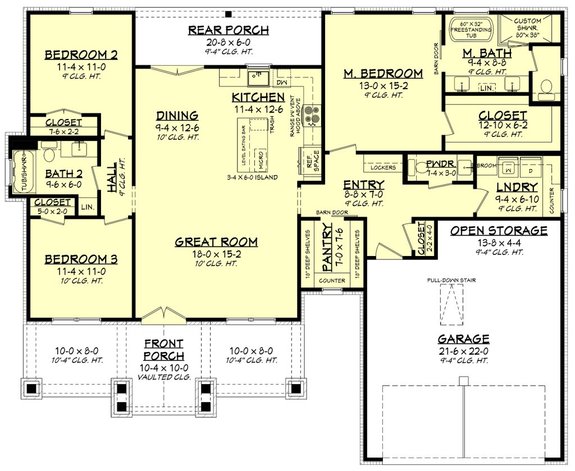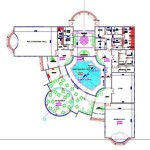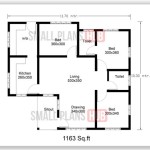Farmhouse With Basement Plans: Maximizing Space and Functionality
The allure of farmhouse living, with its emphasis on rustic charm and connection to nature, continues to captivate homeowners. Incorporating a basement into a farmhouse design significantly expands the functionality of the property, providing valuable space for various purposes, from storage to recreation. Farmhouse with basement plans involves careful consideration of architectural style, site conditions, and owner preferences to create a cohesive and efficient living environment.
This article explores the key considerations when designing a farmhouse with a basement, focusing on the advantages, planning stages, and design elements that contribute to a successful project. It delves into the technical aspects of construction and the aesthetic choices that complement the overall farmhouse aesthetic.
Advantages of Incorporating a Basement into a Farmhouse Design
Adding a basement to a farmhouse offers several practical benefits that extend beyond simply increasing the square footage. It presents an opportunity to create dedicated zones for specific activities, optimize energy efficiency, and enhance the overall value of the property.
One primary advantage is the expanded living space. A basement can be transformed into bedrooms, a home office, a recreational area, or a home theater. This flexibility is particularly valuable for growing families or those who require dedicated spaces for work or hobbies. The ability to customize the basement layout to suit individual needs makes it a highly adaptable asset.
Furthermore, a basement offers substantial storage capacity. Farmhouses often require ample storage for seasonal items, gardening equipment, and supplies related to rural living. A well-designed basement provides a designated area for these items, keeping the main living areas clutter-free. This organized storage solution contributes to a more comfortable and functional living environment.
Energy efficiency is another significant benefit. The earth surrounding the basement walls acts as a natural insulator, helping to maintain a consistent temperature year-round. This reduces the reliance on heating and cooling systems, leading to lower energy bills. A properly insulated basement can significantly improve the overall energy performance of the farmhouse.
Basements can also serve as a safe room during severe weather events. Constructed with reinforced concrete walls, a basement provides a secure shelter from tornadoes, hurricanes, and other natural disasters. This safety aspect offers peace of mind, particularly in regions prone to extreme weather conditions.
Finally, a finished basement adds significant value to the property. It increases the usable square footage, making the farmhouse more attractive to potential buyers. A well-designed and finished basement can be a valuable investment that enhances the long-term value of the property.
Key Planning Considerations for Farmhouse Basement Design
The design and construction of a farmhouse basement require careful planning to ensure structural integrity, functionality, and aesthetic appeal. Several factors must be considered during the planning phase, including site conditions, building codes, and intended use of the space.
Soil type and drainage are critical considerations. A thorough soil analysis should be conducted to determine the soil's bearing capacity and permeability. Poorly draining soil can lead to hydrostatic pressure against the basement walls, potentially causing leaks and structural damage. Proper drainage systems, such as French drains and sump pumps, are essential to prevent water infiltration.
Local building codes and regulations must be strictly adhered to. These codes dictate the minimum ceiling height, egress requirements, and fire safety measures for basements. Compliance with building codes ensures the safety and legality of the basement construction.
The intended use of the basement will significantly influence the design. If the basement is intended for living space, adequate lighting, ventilation, and insulation are crucial. Bedrooms require egress windows for emergency escape, while recreational areas may benefit from open layouts and soundproofing. The specific needs of the intended use should be carefully considered during the design process.
Access to the basement is another important consideration. Interior staircases provide convenient access from the main living areas, while exterior entrances allow for separate access to the basement, which can be useful for workshops or storage areas. The location and design of the access points should be carefully planned to optimize functionality and convenience.
The potential for natural light should also be considered. While basements are typically below ground, strategies can be employed to maximize natural light. Egress windows, window wells, and light wells can bring daylight into the basement, creating a more inviting and comfortable atmosphere. The strategic placement of these features can significantly improve the overall ambiance of the basement.
Furthermore, consider the existing farmhouse architecture. The basement design should seamlessly integrate with the overall farmhouse style. The use of similar materials, colors, and finishes can create a cohesive and harmonious design. The basement should feel like a natural extension of the farmhouse, both aesthetically and functionally.
Design Elements for a Farmhouse Basement
The design elements of a farmhouse basement should reflect the rustic charm and functionality of the overall farmhouse aesthetic. The use of natural materials, warm colors, and comfortable furnishings can create a welcoming and inviting space.
Exposed beams and columns are a characteristic feature of farmhouse design. In a basement, these structural elements can be incorporated into the design, adding visual interest and a rustic touch. Reclaimed wood beams and columns can further enhance the farmhouse aesthetic.
Natural stone is another popular material for farmhouse basements. Stone walls, fireplaces, or flooring can add texture and character to the space. The use of locally sourced stone can further connect the basement to the surrounding landscape.
Shiplap walls are a common feature in farmhouse interiors. In a basement, shiplap can be used to create a warm and inviting atmosphere. The horizontal lines of the shiplap can also visually expand the space.
Warm colors and comfortable furnishings are essential for creating a welcoming basement. Neutral tones, such as beige, gray, and white, provide a versatile backdrop for furniture and accessories. Pops of color can be added through artwork, textiles, and decorative accents. Comfortable seating, soft rugs, and ample lighting create a cozy and inviting atmosphere.
Consider the use of farmhouse-inspired lighting fixtures. Pendant lights, sconces, and chandeliers with rustic finishes can enhance the overall aesthetic. The lighting should be both functional and decorative, providing ample illumination while also contributing to the ambiance of the space.
Storage solutions should be both practical and aesthetically pleasing. Built-in shelves, cabinets, and drawers can provide ample storage space while also adding to the design. The use of reclaimed wood or antique hardware can further enhance the farmhouse aesthetic.
Finally, consider incorporating elements that reflect the surrounding landscape. Artwork depicting nature, potted plants, and natural materials can connect the basement to the outdoors. This connection to nature can create a sense of tranquility and harmony within the space.
Constructing a farmhouse with a basement requires diligent planning and execution. Understanding site conditions, adhering to building codes, and selecting appropriate design elements are crucial for creating a functional and aesthetically pleasing space. The benefits of incorporating a basement, including increased living space, storage capacity, and energy efficiency, make it a worthwhile investment for many farmhouse owners.
Furthermore, the design of the basement should align with the overall architectural style of the farmhouse, creating a cohesive and harmonious living environment. By carefully considering these factors, homeowners can create a farmhouse basement that enhances the value, functionality, and comfort of their property. The integration of practical design elements, coupled with an adherence to the farmhouse aesthetic, results in a basement that is both beautiful and functional.
Ultimately, the success of a farmhouse with basement plans hinges on a collaborative effort between the homeowner, architect, and builder. Open communication, meticulous planning, and attention to detail are essential for achieving the desired outcome. With careful planning and execution, a farmhouse basement can become a valuable asset that enhances the overall quality of life for the homeowners.
The implementation of effective moisture control measures is a key aspect of basement construction that directly impacts the long-term durability and usability of the space. Addressing potential water issues proactively during the design and construction phases mitigates the risk of future problems, such as mold growth, structural damage, and reduced indoor air quality. Implementing a comprehensive waterproofing system safeguards the investment and ensures a healthy and comfortable living environment within the basement.
Furthermore, incorporating sustainable design principles into the construction of a farmhouse with a basement aligns with the values of environmental consciousness often associated with rural living. Utilizing recycled materials, implementing energy-efficient lighting and appliances, and optimizing natural ventilation are examples of sustainable practices that can reduce the environmental footprint of the project and contribute to a healthier planet. Integrating these principles demonstrates a commitment to responsible building practices and creates a living space that is both comfortable and environmentally sound.

Modern Farmhouse Plan W Walkout Basement Drummond House Plans

Walkout Basement Farm House Style Plan 8821

Farmhouse Plans With Basement Houseplans Com

Exclusive Modern Farmhouse Plan With Optional Walk Out Basement 910073whd Architectural Designs House Plans

Versatile Spacious House Plans With Basements Houseplans Blog Com

Modern Farmhouse Floor Plan 3 Bedrms 5 Baths 1892 Sq Ft 205 1231

Small Farmhouse Plans Fit For Fall Blog Eplans Com
:max_bytes(150000):strip_icc()/SL-2001-tennessee-farmhouse-c325fe44f6f34dac8bd5862cb721b2e6.jpg?strip=all)
20 Farmhouse Plans That You Ll Want To Call Home

4 Bedroom 1 Story Modern Farmhouse Style Plan With Outdoor Living Area And Bonus Room Westchester Craftsman House Plans

House Plans With Finished Basement Home Floor








